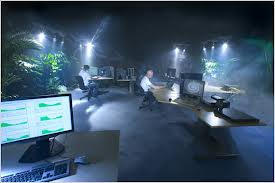This article is more than 1 year old
Hong Kong plans cavernous underground data centres
Going underground
Engineering hurdles
According to Amod Jayawant, director of critical environments at real estate services firm CBRE, digging a data bunker won't be easy.
“It’s a great idea – as you know underground rock formations, caves, caverns etc. maintain an even all year round cool temperature,” he told El Reg. “However, the technical side of this equation is not so pretty. It’s really a bunch of questions, the answers to which are sometimes not feasible or extremely expensive.”
These questions revolve around how to supply power and fit generators; how to vent diesel fumes and get fresh air in; how to get diesel tanks underground; and how to dehumidify the area, he explained.
Hong Kong’s plans for underground datacentres are not entirely without precedent. Green Mountain in Norway, cooled by an adjacent fjord, claims to be the “greenest datacentre in the world”, while the appropriately named Cavern Technologies runs an underground datacentre in Kansas City.
Hong Kong’s different to both of those countries, however, in that its decision to go underground has been prompted by a chronic shortage of land to build on.

The government is desperately trying to promote the SAR as Asia’s pre-eminent ICT hub, with its latest project launched last year offering tax breaks for firms deciding to locate their datacentres in former factories.
However, that’s not necessarily going to attract investment, according to legislative councillor, Charles Mok.
“The government tried to encourage the conversion of [these sites] into mid-tier datacentres by waiving the fee for ‘change of land’,” he explained.
“That’s a nice idea but the problem is that paying less money is not a concern, finding the right building is.”
Government support
The underground plans do seem to have support in high places. Chief secretary Carrie Lam is certainly a fan of the city-state expanding its building underground,labelling what lies beneath Hong Kong as a “unique geological asset”.
Aside from a comprehensive subway network (MTR), the SAR has already built a sewage treatment works, waste transfer facility and two 12,000 m3 capacity water reservoirs, so it would seem up to the engineering task.
But politically, such huge infrastructure investments usually take time, even in a cashed-up, can-do town like Hong Kong.

Pionen White Mountains, Sweden
Arup director Mark Wallace stood up during a question and answer session to drum up support from the private sector, urging data centre firms to get on board when the plans are finally given the green light. However, even he admitted that reaching even this point will take “quite a few years”.
For CBRE’s Jayawant the project will only stand a chance if it gets the 100 per cent backing of the SAR government.
“In Europe they have used cold war bunkers, but if in HK we have to start from scratch that’s a huge expense,” he said.
“No commercial company will be willing to invest that kind of money.” ®
